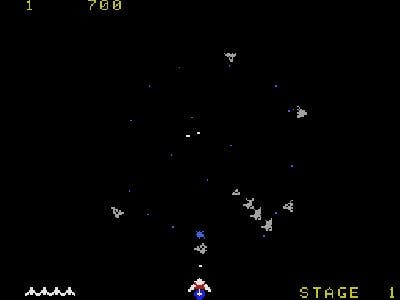Gyruss
Two warps to Neptune!
While Gyruss holds a celebrated and respected place in arcade history, it's a distinct shame that game design legend Yoshiki Okamoto didn't deliver it to gamers just a few years earlier. During the Space Invaders craze and subsequent coin shortages that Gyruss' ancestor caused, this game had the potential to perpetuate the world's crippling small change famine.
Like all brilliant ideas, Gyruss is a clone that's so well camouflaged by the unique subtleties of its design most gamers don't quickly recognise its obvious influences. Though it's certainly not a criticism, Gyruss is without question a brilliant and blatant redesign of Space Invaders. While players loved the concept of piloting Earth's last defence against a xenophobic invader in 1978, Gyruss delivered the same basic gameplay but astutely put gamers right in the middle of the action by providing a perspective as seen by the pilot, and not a dissociative third-person viewpoint.
Rocketing through a tube-like hyperspace from planet to planet, players had to battle their way from Pluto to Earth while fending off a legion of attacking spacecraft. By skirting around the pseudo-circumference of the warp tunnel in the wonderfully balletic spaceship, Gyruss was granted a feeling of dangerous break-neck velocity alongside the thrills of futuristic warfare; a brilliant and far more pragmatic approximation of what an outer space battle might entail.

The vertiginous nature of the high-octane space chase was further epitomised by the first arcade game use of stereo sound, warning daredevil pilots of the impending rear attacks and further drawing players into the perilous action.
While talk of Galaga and Tempest is more common when people search for Okamoto's influences (who left Konami and joined Capcom after pay disputes arising from this game), it'd be far more reasonable and accurate to crown Gyruss as Space Invaders 2.
